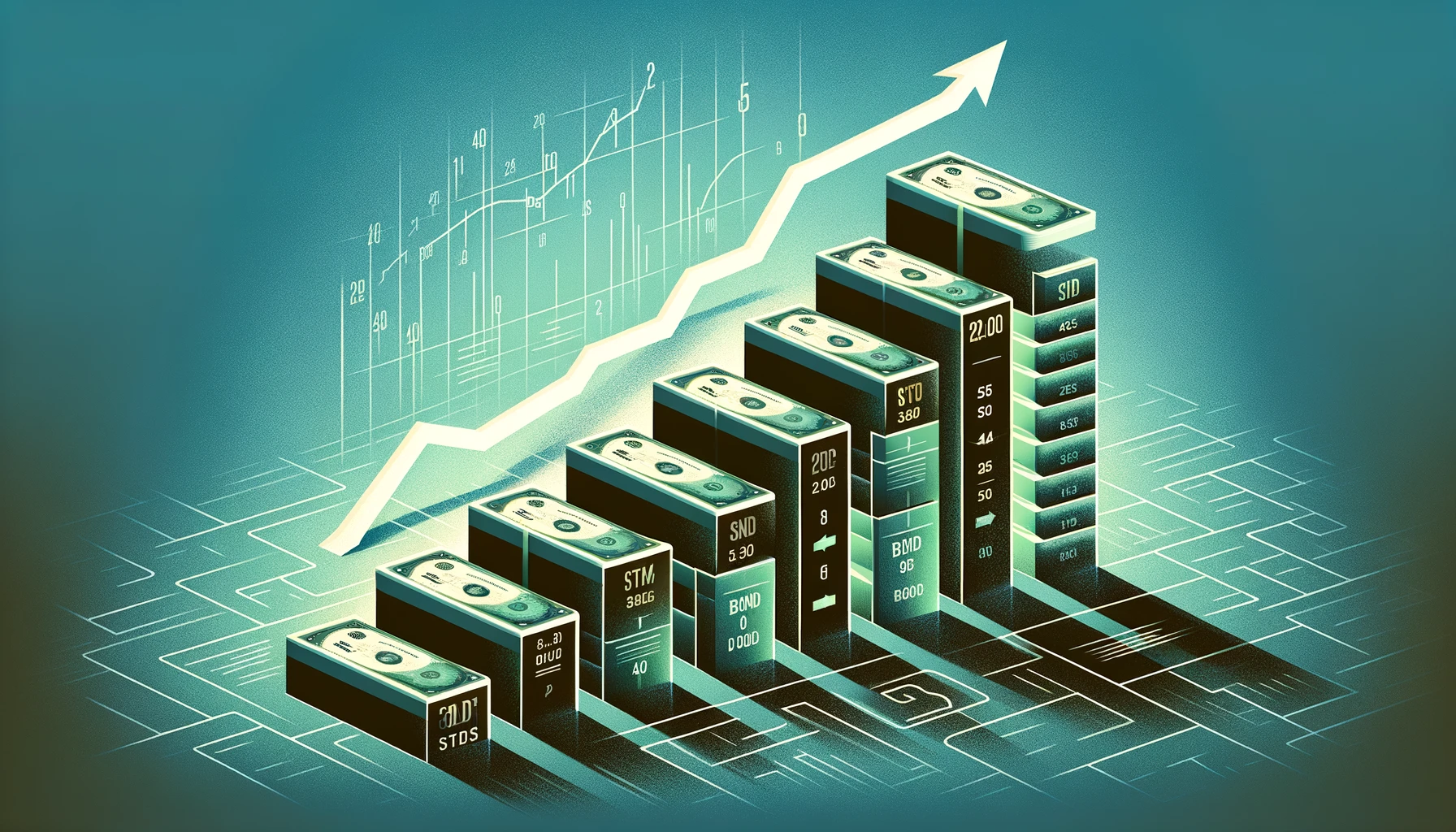Business Development Companies Stocks
As a business development investor, I have come across an interesting statistic that may pique the interest of investors seeking to diversify their portfolio in 2023 with a range of public companies.
Did you know that Business Development Companies (BDCs) have outperformed the S&P 500 over the past decade?
According to data from the National Association of Small Business Investment Companies, BDCs have delivered an average annual return of 10.6% compared to the S&P 500’s average annual return of 9.8%.
For those unfamiliar, BDCs are publicly traded companies and closed-end investment companies that invest in small and mid-sized businesses, providing them with capital and managerial expertise.
These companies typically have high dividend yields and offer exposure to private market investments not available in traditional public markets. The often substantial dividend payouts can make them attractive!
As investors seek alternatives to traditional stocks and bonds, many are turning towards BDCs as a way to diversify their portfolios while potentially reaping higher returns.
In this article, we will explore the world of BDCs – how they work, what sets them apart from other investment vehicles, and why they may be worth considering for your investment strategy.

What Is A BDC?
If you’re looking for a high-yield investment option, business development companies (BDCs) may be worth considering. These companies offer investors the opportunity to invest in small- and medium-sized companies that might not have access to traditional financing. BDCs typically operate as closed-end funds and are required by law to pay out at least 90% of their taxable income as dividends, and were established with the Investment Company Act of 1940.
BDCs are unique because they provide both debt and equity financing to the companies they invest in. This means that instead of just buying stock in a company, BDCs can also lend money to that company. By providing both types of financing, BDCs can help smaller businesses grow while also generating income for investors.
Investing in BDCs can be a good way to diversify your portfolio and potentially earn higher returns than other types of investments. Many people investing for income (aka income investors) have BDC investments due to the high yields and ability to create a dividend snowball. However, it’s important to remember that like all investments, there are risks involved. Because BDCs primarily invest in smaller companies, they may be more vulnerable to economic downturns or industry-specific issues.
If you’re interested in investing in BDC stocks, it’s important to do your research and understand how these companies operate. In the next section, we’ll take a closer look at what makes BDCs unique and what factors you should consider when evaluating potential investments.
Understanding Bdcs
Ironically, while many investors are familiar with stocks and bonds, Business Development Companies (BDCs) remain obscure to the general public.
BDCs are publicly traded investment firms that lend capital to small- and medium-sized businesses. While they may not be as well-known as other types of investment vehicles, BDCs offer unique advantages for those looking to diversify their portfolio.
Investing in Business Development Companies allows investors to gain exposure to a diverse range of private companies that would otherwise be inaccessible. Typically, BDCs invest in portfolio companies across various industries such as healthcare, technology, and energy. This approach provides investors with access to a wide array of businesses from different sectors which can help mitigate risk.
One of the main benefits of investing in BDCs is their high dividend yields compared to other traditional investments such as stocks and bonds. BDCs are required by law to distribute at least 90% of their taxable income to shareholders in the form of dividends. This means that investors can earn a steady stream of income from their investment while also benefiting from potential capital appreciation.
Overall, while BDCs may not be as well-known as other types of investments, they provide a unique opportunity for those looking to diversify their portfolios and generate income through high dividend yields. In the next section, we’ll explore the different types of BDCs available on the market and what sets them apart from each other.
Types Of BDCs
When investing in business development companies (BDCs) stocks, it’s important to understand the different types of BDCs available.
BDCs are typically classified into two categories: internally managed and externally managed. Internally managed BDCs have their own employees that manage the portfolio of investments, while externally managed BDCs outsource this function to a third-party investment adviser.
Another way to classify BDCs is by their investment focus. Some BDCs invest primarily in middle-market or medium-sized companies, while others focus on distressed companies that need financial assistance to turn their operations around. It’s important for investors to choose a BDC that aligns with their investment goals and risk tolerance.
In addition to these classifications, there are also hybrid BDCs that combine elements of both internally and externally managed structures as well as different investment focuses. These hybrid BDCs may offer more diverse investment opportunities but can also be more complex to analyze.
Overall, understanding the types of business development companies available can help investors make informed decisions when choosing which BDC stocks to invest in.
By carefully researching and selecting a BDC that aligns with their goals and risk tolerance, investors can potentially benefit from the growth potential and high dividend yields offered by these unique investment vehicles.
As investors consider the various types of business development companies available, it’s also worth comparing them to another popular investment option: venture capital. While both options involve investing in private businesses, there are key differences in terms of structure, risk profile, and potential returns.
Let’s take a closer look at how these two options compare in our next section.

BDCs vs. Venture Capital
Investing in business development companies (BDCs) can be a lucrative option for investors looking to support small businesses and earn returns at the same time. BDCs are types of closed-end investment funds that invest in and lend money to small and mid-sized businesses. These companies often provide debt financing, equity investments, or a combination of both.
One key difference between BDCs and venture capital is their investment focus. While venture capitalists typically invest in early-stage startups with high growth potential, BDCs tend to focus more on established businesses with a proven track record of success. This means that BDCs are often less risky than venture capital investments, but they also offer lower potential returns.
Another major difference between BDCs and venture capital is the way they raise capital. Venture capital firms typically raise funds from institutional investors like pension funds or endowments, while BDCs can raise money from both institutions and individual investors through public offerings or private placements.
Despite their differences, both BDCs and venture capital play an important role in supporting small business growth and innovation. By providing funding and expertise to entrepreneurs, these types of business development companies help create jobs, drive economic growth, and improve communities.
As we continue to explore the world of BDCs, it’s important to understand how these companies work and what factors influence their performance. In the next section, we’ll take a closer look at the mechanics of BDC investing and discuss some key considerations for investors looking to add these unique securities to their portfolios.
How BDCs Work
Investing in business development companies (BDCs) can be a lucrative option for investors who are looking to diversify their portfolio. But how do BDCs work, and how do they make money?
BDCs are specialized investment funds that are designed to provide capital to small and middle-market companies. These companies typically have difficulty obtaining financing from traditional lenders, such as banks or investment firms. BDCs step in and offer these companies the capital they need to grow and expand their businesses.
BDC stocks are publicly traded on major stock exchanges, just like any other stock. Investors can buy shares of these stocks, which represent ownership in the underlying BDC fund. As the BDC invests in its portfolio companies, it generates income and profits, which are then distributed to shareholders in the form of dividends.
One way that BDCs make money is through interest payments on loans made to their portfolio companies. When a BDC loans money to a company, it receives periodic interest payments on that loan until it is repaid in full.
In addition to interest income, BDCs may also receive equity stakes in their portfolio companies, which can generate additional returns if those companies experience growth or go public.
Transitioning into the subsequent section about bdc lending, it’s important to understand how this type of lending works within the context of a BDC’s operations.
BDC Lending
BDC Lending is an essential part of the business development companies’ financial services. For those seeking to invest in BDCs, understanding BDC lending is crucial.
At its core, BDC lending involves providing debt and equity financing to middle market companies with limited access to capital markets. This type of financing typically comes with higher interest rates than traditional bank loans but also offers more flexible terms.
Investing in BDCs allows investors to diversify their portfolio while potentially earning high returns. However, it’s important to note that not all BDCs are created equal when it comes to their lending practices.
Some may focus on riskier investments, while others may prioritize more secure but lower-yield opportunities. Investors need to do their due diligence when researching potential BDC investments and ensure that the company’s lending practices align with their risk tolerance and investment goals.
BDC lending can be beneficial for middle market companies that struggle to obtain financing from traditional sources such as banks or private equity firms. These companies often have strong growth potential but lack the necessary collateral or credit history required by traditional lenders. In contrast, BDCs provide a less restrictive option for these businesses by offering customized financing solutions tailored to their individual needs.
In summary, BDC lending plays a vital role in the financial ecosystem by providing much-needed financing options for middle market companies while also offering attractive investment opportunities for investors seeking diversification and potential high returns. Understanding the intricacies of this type of investing is crucial before making any investment decisions in the space.

Advantages Of BDC Investing
Investing in business development companies (BDC) stocks can provide a multitude of advantages for investors. BDCs are known to offer higher dividend yields compared to other stocks, making them an attractive option for income-seeking investors. Furthermore, BDCs typically have a lower correlation with the overall market, which makes them a great addition to any portfolio looking for diversification.
When it comes to investing in BDCs, there are several best BDC stocks to buy that stand out from the rest. These companies have strong financials, diverse portfolios, and experienced management teams that can navigate challenging economic times. Some of the best BDC stocks to buy include Ares Capital Corporation (ARCC), Main Street Capital Corporation (MAIN), and Prospect Capital Corporation (PSEC).
One of the biggest advantages of investing in BDC stocks is their dividend yield. Unlike traditional stocks, which may offer lower dividends or no dividends at all, BDCs generally distribute a large portion of their earnings as dividends. This makes them an excellent option for those seeking income from their investments.
Overall, investing in BDCs can be a great way to diversify your portfolio while also earning income through high dividend yields. By choosing some of the best BDC stocks to buy and incorporating them into your investment strategy, you can see significant returns while minimizing risk.
In the next section, we will explore some of the risks associated with investing in BDCs and how to mitigate them.
Risks Of BDC Investing
As we’ve discussed, investing in business development companies (BDCs) can offer numerous advantages. However, it’s important to understand the risks involved as well.
One significant risk to keep in mind is interest rates. BDCs make money by borrowing at low rates and lending at higher rates. But when interest rates rise, their borrowing costs increase, which can eat into profits. Additionally, BDCs are sensitive to interest rate fluctuations because they often use debt to finance investments.
Another risk to consider is the potential for industry-specific challenges. BDCs typically invest in small and mid-sized businesses that may face difficulties such as economic downturns or increased competition. As a result, a BDC’s portfolio may suffer if one or more of its portfolio companies experience financial hardship. A key issue investors will need to consider is whether their dividends are safe.
Finally, it’s important to choose quality BDC stocks when investing in this sector. Not all BDCs are created equal – some have better management teams or more diversified portfolios than others. Before investing, be sure to do your research and select companies with strong track records and solid growth prospects.
Transitioning into our next section on choosing quality BDCs, it’s important to note that there are steps you can take to mitigate the risks associated with this type of investment. By carefully selecting high-quality companies and staying up-to-date on market trends and interest rate movements, you can build a strong portfolio that offers both growth potential and downside protection.
Choosing Quality BDCs
As a business development investor, it is essential to choose quality BDCs when looking to invest in BDC stocks. Not all BDCs are created equal, and investing in the wrong one could lead to negative returns. Here are some tips on how to choose the best BDCs:
Look for consistent dividend payments: A reliable way to assess the performance of a BDC is by checking its dividend history. The best BDCs will have a consistent track record of paying dividends without reducing them.
Evaluate the management team: The management team plays an integral role in the success of a BDC. Look for experienced executives with a clear strategy for managing risk and generating returns.
Analyze the portfolio: Take time to understand the composition of the BDC’s investment portfolio. A well-diversified portfolio reduces risk and ensures steady income streams.
Check financial strength: The financial health of a BDC is crucial when considering investing in it. Ensure that its debt levels are manageable, and its cash flow can cover dividend payments.
Choosing quality BDCs requires careful analysis and research, but it’s worth it in the long run. By following these tips, investors can identify the best BDCs with strong potential for growth and profitability.
Looking ahead, investing in BDcs offers attractive benefits such as high yields and capital appreciation potential. In our next section, we’ll explore why investing in business development companies should be part of every investor’s portfolio.

Investing In BDCs
As the saying goes, ‘Invest in quality, not quantity.’ This rings true when it comes to choosing the best BDC stocks to buy.
Investing in business development companies (BDCs) can be a great way to diversify your portfolio and make money, but not all BDCs are created equal. It’s important to do your research and choose wisely.
One of the reasons why investing in BDCs has become increasingly popular is because of the high yields they offer. These companies are required by law to distribute at least 90% of their taxable income to shareholders in order to maintain their status as a regulated investment company (RIC).
This means that BDCs offer attractive dividend yields that can provide a steady stream of income for investors. However, it’s important to note that not all BDCs can sustain these high dividend payouts over the long term.
Some may have unsustainable payout ratios or may be investing in risky assets that could lead to losses. That’s why it’s crucial to look beyond the dividend yield and analyze a company’s financial health, management team, and investment strategy before investing.
In summary, while investing in BDCs can be a lucrative opportunity for those seeking higher yields, it’s important to do your due diligence and choose quality over quantity. By carefully analyzing a company’s financial health and investment strategy, you can identify the best BDC stocks to buy and potentially reap significant rewards from this asset class.
There are a range of BDCs. Some, like Main Street Capital (MAIN) have equity and loan investments. Others, like Capital Southwest Corporation (CSWC) have a stronger focus on lending and debt.
In the next section, we will dive deeper into how taxes impact investments in BDCs.
BDCs and Taxes
As a business development investor, it’s important to understand the tax implications of investing in business development companies (BDCs) stocks. BDCs are regulated investment companies that make money by investing in and lending to small and mid-sized businesses. While they offer the potential for high yields and diversification, investors need to be aware of how income tax affects their investments.
One advantage of investing in BDCs is that they generally pay higher dividends than other types of stocks. However, these dividends are subject to both federal and state income taxes. Investors should also keep in mind that some BDCs may distribute capital gains as well, which can also be taxed at a higher rate.
Another important factor is the type of account an investor holds their BDC shares in. For example, holding BDC shares in a taxable account means that any dividends or capital gains will be subject to taxes each year. On the other hand, holding shares in a tax-advantaged account such as an IRA or 401(k) can provide significant tax benefits.
It’s also worth noting that some BDCs may elect to be treated as ‘pass-through entities’ for tax purposes. This means that instead of paying taxes on corporate profits, the company passes its taxable income through to its shareholders who then report it on their individual tax returns. This can result in lower overall taxation for investors.
Investors interested in adding BDCs to their portfolio should consult with a financial advisor or accountant to determine the best strategy based on their individual circumstances. With careful planning and consideration, investing in BDC stocks can offer attractive returns while minimizing the impact of income taxes on your portfolio.
Looking ahead, exploring exclusive investment opportunities is an exciting way to diversify your portfolio even further. Let’s explore some ways you can access these opportunities and potentially increase your returns even more.
Accessing Exclusive Investment Opportunities
As an investor, you’re always on the lookout for exclusive investment opportunities. And when it comes to business development companies stocks (BDCs), investing in them can be highly profitable.
BDCs are publicly traded companies that invest in small and medium-sized businesses, providing capital and other services. The best BDC stocks offer investors a chance to own a diversified portfolio of these businesses. This diversity helps reduce the risk of investing in any one company.
In addition, because BDCs are required by law to pay out at least 90% of their taxable income as dividends, investing in them offers a reliable stream of income. But the real value of BDCs lies in their ability to offer access to exclusive investment opportunities that aren’t available to individual investors.
Because they invest in private companies, which often don’t have access to traditional financing options, BDCs can provide capital at attractive rates while also offering management expertise and strategic guidance. If you’re looking for exclusive investment opportunities, then you should consider investing in business development companies stocks.
But before you do, it’s important to carefully research the best BDC stocks available and understand the risks involved. By doing so, you’ll be able to take advantage of this unique asset class and potentially grow your wealth over time.
With an understanding of how BDCs work and what makes them unique investments, let’s now explore some common types of BDCs available on the market today.
Common Types Of BDCs
As an investor in the field of business development companies (BDCs), it’s crucial to have a deep understanding of the common types of BDCs. These types represent different structures and strategies that can impact the success of BDC stocks. Knowing which type of BDC a company is will help investors make informed decisions about which BDC stocks to buy.
First, we have asset-based BDCs. These are the largest business development companies by assets and invest primarily in loans secured by tangible assets such as real estate, equipment, or inventory. They’re considered to be lower risk than other types of BDCs because their investments are backed by physical collateral.
Second, there are cash flow-based BDCs. These invest in loans that are backed by future cash flows rather than tangible assets. This type of BDC is considered higher risk than asset-based ones since they rely heavily on projected income and revenue streams.
Third, we have hybrid BDCs that have both asset-based and cash flow-based investments in their portfolios. They offer a balance between risk and reward for investors looking for exposure to both types of investments.
Lastly, there are specialty finance BDCs that invest in niche areas such as healthcare or technology. This type offers investors the opportunity to diversify their portfolio while also investing in specific industries they believe will perform well over time.
Investing in BDcs can be a lucrative way to earn passive income streams through dividends paid out regularly to shareholders. But before investing, it’s important to do your research and understand the different types of bdcs available so you can choose the best bdc stocks to buy for your investment goals and risk tolerance level.
In the next section, we’ll take a closer look at some highest-rated bdc stocks that you might want to consider adding to your portfolio.
Highest-Rated BDC Stocks
Looking for the highest-rated BDC stocks to invest in can be a daunting task, but it’s certainly worth the effort. As a business development investor, I have researched and analyzed the market to identify the best BDC stocks to buy. These are publicly traded companies that specialize in providing financing solutions to middle-market businesses.
One of the key factors to consider when investing in BDCs is their dividend yield. This is the amount of money a company pays out to its shareholders as a percentage of its stock price. The higher the dividend yield, the more income you can earn from your investment. Some of the best BDC stocks to buy right now have dividend yields above 10%, which is quite attractive for income investors.
Another important factor to consider when investing in BDCs is their track record of performance. You want to invest in companies that have consistently delivered strong returns over time. By looking at their historical financial data and analyzing their management team and investment strategies, you can get a better sense of how well they are positioned for future growth.
Overall, investing in BDCs can be a great way to diversify your portfolio and generate income. However, it’s important to do your due diligence before investing in any particular company. By focusing on factors like dividend yield and performance history, you can identify some of the best BDC stocks to buy right now.
As interest rates continue to rise, some BDCs may be better positioned than others to weather the storm. In the next section, we’ll take a closer look at these ‘rising rate’ BDcs and explore why they might be worth considering for your investment portfolio.
BDCs Positioned For Rising Rates
Moving on from the highest-rated BDC stocks, let’s take a look at how BDCs are positioned for rising interest rates. As an investor in this field, I can attest that investing in BDCs is a smart move given the current market conditions.
But before we delve deeper into why that is, let me first provide an analogy to help you visualize the concept of interest rates. Think of interest rates as the tide that governs the ocean of finance – it ebbs and flows, affecting everything in its path. In this case, rising interest rates mean higher borrowing costs for companies. For BDCs, which lend money to businesses, this could potentially lead to increased revenue and growth opportunities.
Moreover, many BDCs are required by law to pay out most of their earnings as dividends to shareholders – making them an attractive option for income-seeking investors. Now let’s talk numbers: BDCs typically have high dividend yields compared to other stocks because they are required by law to distribute most of their taxable income to shareholders as dividends. This makes them a popular choice among investors looking for steady income streams.
However, rising interest rates could lead to higher borrowing costs for these companies, which could potentially impact their profitability. Despite this potential drawback, there are still many reasons why investing in BDC stocks is a smart move.
For one thing, many of these companies have already taken steps to mitigate any potential risks associated with rising interest rates by using floating rate debt instruments or hedging strategies. Additionally, the increased revenue potential resulting from rising interest rates will likely outweigh any negative impacts on profitability.
In conclusion, while rising interest rates may pose some challenges for BDCs and their investors in terms of profitability and dividend yield, these companies are still well-positioned to weather any storms that come their way. With high dividend yields and potential growth opportunities on the horizon, now is a great time to invest in BDCs.
Frequently Asked Questions
What Is The Historical Performance Of BDC Stocks Compared To Other Types Of Investments?
Historically, BDC stocks have proven to be a solid investment option compared to other types of investments. In fact, their long-term performance has often exceeded that of traditional mutual funds and index funds.
While the market can be unpredictable, savvy investors understand that diversifying their portfolio with BDC stocks can provide a level of stability and growth potential that is not always present in other investment options.
As a business development investor, it’s important to consider all factors when making investment recommendations, but it’s clear that BDCs have a track record of success that should not be overlooked by those seeking financial freedom.
How Are BDCs Regulated And What Oversight Do They Have?
While many investors may be drawn to the potential returns of business development companies (BDCs), it is important to understand the regulatory landscape in which they operate.
BDCs are subject to oversight by both the Securities and Exchange Commission (SEC) and their own board of directors, who must ensure that the company operates within its investment mandate and adheres to strict leverage limits.
Additionally, BDCs are required to make regular filings with the SEC, including quarterly financial statements and annual reports.
By understanding these regulations, investors can better evaluate the risks and rewards of investing in BDCs, while also ensuring that they are making informed decisions about their investments.
Can Individuals Invest Directly In A Bdc, Or Do They Need To Go Through A Broker Or Financial Advisor?
Individuals who are looking to invest in BDCs have the option of investing directly or going through a broker or financial advisor.
Direct investment is possible but requires knowledge and expertise in analyzing financial statements, market trends, and other relevant factors.
Going through a broker or financial advisor can provide guidance and access to a wider range of investment options, but may come with additional fees and charges.
Ultimately, the decision on how to invest in BDCs depends on an individual’s level of knowledge, experience, and risk tolerance.
However, it’s important for investors to remember that investing always carries some level of risk, and to thoroughly research any potential investments before making a decision.
How Do BDCs Decide Which Companies To Invest In And How Much To Lend?
Like a skilled explorer, business development companies (BDCs) must navigate the treacherous terrain of the financial world to find promising companies to invest in.
As a BDC investor, our team uses a variety of data-driven methods to assess which businesses have the potential for long-term growth and profitability. We analyze financial statements, industry trends, and management teams to determine the likelihood of success.
Once we’ve identified a company with strong potential, we work closely with their management team to craft a financing package that meets their needs while minimizing risk for our investors.
At the end of the day, our goal is to help these companies reach new heights while providing our investors with the freedom and flexibility they deserve.
What Impact Do Changes In Interest Rates Have On BDC Stocks And Their Underlying Investments?
Changes in interest rates have a significant impact on BDC investments.
As a business development investor, it’s important to keep an eye on the Federal Reserve’s monetary policy decisions and how they may affect the economy as a whole.
Rising interest rates can increase borrowing costs for BDC portfolio companies, potentially leading to lower investment returns.
On the other hand, falling interest rates can make it easier for companies to borrow funds and expand their operations, which could lead to higher returns for BDCs.
It’s crucial for investors who have a subconscious desire for freedom and flexibility to closely monitor the interest rate environment when considering investing in BDC stocks.
Conclusion
In conclusion, as a business development investor, I recommend that investors carefully consider the historical performance, regulation and oversight, and decision-making processes of BDCs before investing directly or through a broker or financial advisor.
While BDCs can offer attractive yields and diversification opportunities, they also come with risks, such as credit quality, portfolio concentration, and interest rate sensitivity.
The future of BDC stocks is uncertain and depends on various factors such as economic growth, market conditions, regulatory changes, and individual company performance.
Therefore, prudent investors should regularly monitor their BDC holdings and stay informed about industry trends and developments. Only then can they make informed decisions about whether to hold or sell their BDC investments.

Dr. Lincoln C. Wood teaches at the University of Otago in New Zealand. He is an avid investor and educator. He loves cash flow, income, and dividends when investing. He likes to buy undervalued companies with strong advantages and earnings growth.







